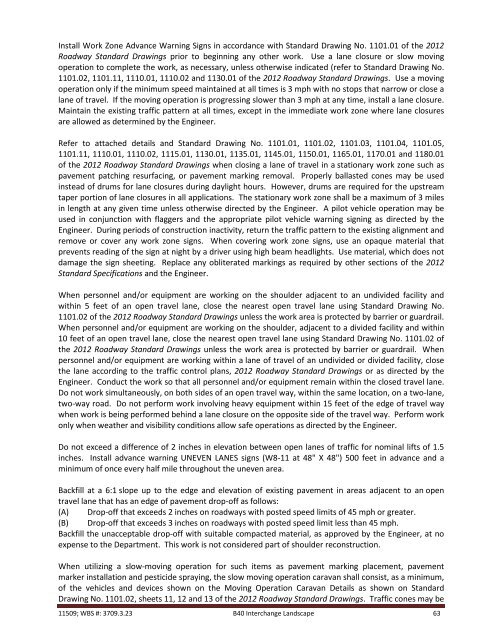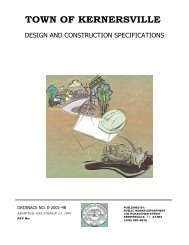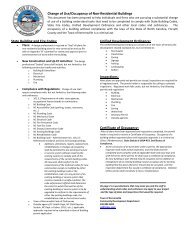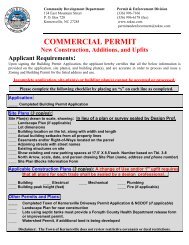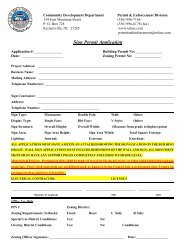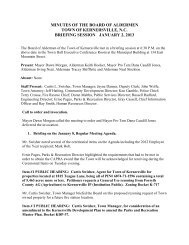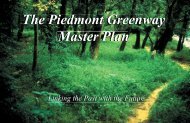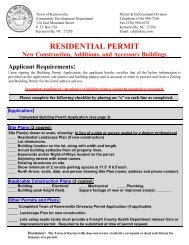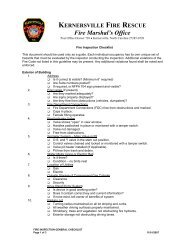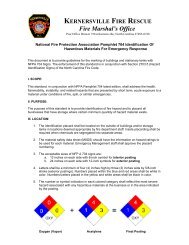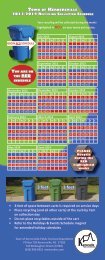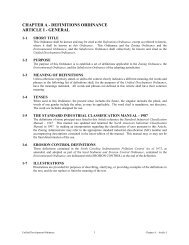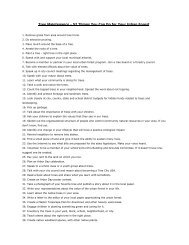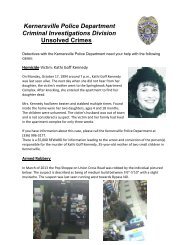Kernersville B-40 & South - Town of Kernersville
Kernersville B-40 & South - Town of Kernersville
Kernersville B-40 & South - Town of Kernersville
You also want an ePaper? Increase the reach of your titles
YUMPU automatically turns print PDFs into web optimized ePapers that Google loves.
Install Work Zone Advance Warning Signs in accordance with Standard Drawing No. 1101.01 <strong>of</strong> the 2012<br />
Roadway Standard Drawings prior to beginning any other work. Use a lane closure or slow moving<br />
operation to complete the work, as necessary, unless otherwise indicated (refer to Standard Drawing No.<br />
1101.02, 1101.11, 1110.01, 1110.02 and 1130.01 <strong>of</strong> the 2012 Roadway Standard Drawings. Use a moving<br />
operation only if the minimum speed maintained at all times is 3 mph with no stops that narrow or close a<br />
lane <strong>of</strong> travel. If the moving operation is progressing slower than 3 mph at any time, install a lane closure.<br />
Maintain the existing traffic pattern at all times, except in the immediate work zone where lane closures<br />
are allowed as determined by the Engineer.<br />
Refer to attached details and Standard Drawing No. 1101.01, 1101.02, 1101.03, 1101.04, 1101.05,<br />
1101.11, 1110.01, 1110.02, 1115.01, 1130.01, 1135.01, 1145.01, 1150.01, 1165.01, 1170.01 and 1180.01<br />
<strong>of</strong> the 2012 Roadway Standard Drawings when closing a lane <strong>of</strong> travel in a stationary work zone such as<br />
pavement patching resurfacing, or pavement marking removal. Properly ballasted cones may be used<br />
instead <strong>of</strong> drums for lane closures during daylight hours. However, drums are required for the upstream<br />
taper portion <strong>of</strong> lane closures in all applications. The stationary work zone shall be a maximum <strong>of</strong> 3 miles<br />
in length at any given time unless otherwise directed by the Engineer. A pilot vehicle operation may be<br />
used in conjunction with flaggers and the appropriate pilot vehicle warning signing as directed by the<br />
Engineer. During periods <strong>of</strong> construction inactivity, return the traffic pattern to the existing alignment and<br />
remove or cover any work zone signs. When covering work zone signs, use an opaque material that<br />
prevents reading <strong>of</strong> the sign at night by a driver using high beam headlights. Use material, which does not<br />
damage the sign sheeting. Replace any obliterated markings as required by other sections <strong>of</strong> the 2012<br />
Standard Specifications and the Engineer.<br />
When personnel and/or equipment are working on the shoulder adjacent to an undivided facility and<br />
within 5 feet <strong>of</strong> an open travel lane, close the nearest open travel lane using Standard Drawing No.<br />
1101.02 <strong>of</strong> the 2012 Roadway Standard Drawings unless the work area is protected by barrier or guardrail.<br />
When personnel and/or equipment are working on the shoulder, adjacent to a divided facility and within<br />
10 feet <strong>of</strong> an open travel lane, close the nearest open travel lane using Standard Drawing No. 1101.02 <strong>of</strong><br />
the 2012 Roadway Standard Drawings unless the work area is protected by barrier or guardrail. When<br />
personnel and/or equipment are working within a lane <strong>of</strong> travel <strong>of</strong> an undivided or divided facility, close<br />
the lane according to the traffic control plans, 2012 Roadway Standard Drawings or as directed by the<br />
Engineer. Conduct the work so that all personnel and/or equipment remain within the closed travel lane.<br />
Do not work simultaneously, on both sides <strong>of</strong> an open travel way, within the same location, on a two-lane,<br />
two-way road. Do not perform work involving heavy equipment within 15 feet <strong>of</strong> the edge <strong>of</strong> travel way<br />
when work is being performed behind a lane closure on the opposite side <strong>of</strong> the travel way. Perform work<br />
only when weather and visibility conditions allow safe operations as directed by the Engineer.<br />
Do not exceed a difference <strong>of</strong> 2 inches in elevation between open lanes <strong>of</strong> traffic for nominal lifts <strong>of</strong> 1.5<br />
inches. Install advance warning UNEVEN LANES signs (W8-11 at 48" X 48") 500 feet in advance and a<br />
minimum <strong>of</strong> once every half mile throughout the uneven area.<br />
Backfill at a 6:1 slope up to the edge and elevation <strong>of</strong> existing pavement in areas adjacent to an open<br />
travel lane that has an edge <strong>of</strong> pavement drop-<strong>of</strong>f as follows:<br />
(A) Drop-<strong>of</strong>f that exceeds 2 inches on roadways with posted speed limits <strong>of</strong> 45 mph or greater.<br />
(B) Drop-<strong>of</strong>f that exceeds 3 inches on roadways with posted speed limit less than 45 mph.<br />
Backfill the unacceptable drop-<strong>of</strong>f with suitable compacted material, as approved by the Engineer, at no<br />
expense to the Department. This work is not considered part <strong>of</strong> shoulder reconstruction.<br />
When utilizing a slow-moving operation for such items as pavement marking placement, pavement<br />
marker installation and pesticide spraying, the slow moving operation caravan shall consist, as a minimum,<br />
<strong>of</strong> the vehicles and devices shown on the Moving Operation Caravan Details as shown on Standard<br />
Drawing No. 1101.02, sheets 11, 12 and 13 <strong>of</strong> the 2012 Roadway Standard Drawings. Traffic cones may be<br />
11509; WBS #: 3709.3.23 B<strong>40</strong> Interchange Landscape 63


